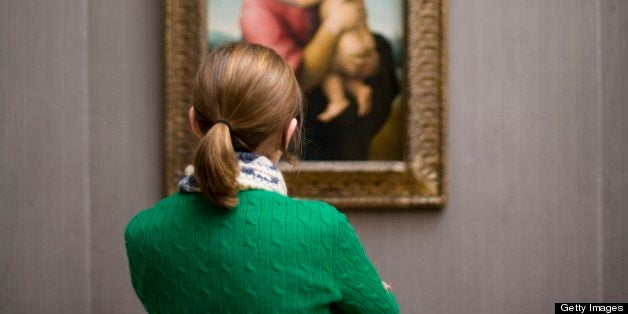
I love art and I hate museums.
Willie Sutton said (apocryphally) that he robbed banks "because that's where the money is." If you want to see art, at least by dead artists, a museum is where the art is. No way around it. You can't long content yourself with coffee table art books or wall posters or notecards. Visual art is an in-person experience.
The public museum is a relatively recent artifact. The museum emerged from the collections of individuals of means and taste (borrowed or presumed) who acquired (bought or plundered) desirable objects for themselves. The Louvre was Louis XIV's personal cabinet of curiosities, until the French Revolution appropriated the building and collection for the People and opened its doors to the masses. The museum has been public palace and secular church ever since. The private origins of the museum might suggest that you're not really welcome. Businessman and art collector Albert Barnes felt that way. He required potential visitors to his extraordinary private collection to write him a personal letter requesting an appointment to view the collection. James A. Michener and T.S. Eliot (among lesser others) were turned away, with Barnes' dog Fidèle-de-Port-Manech often signing the many rejection letters. Public access was strictly limited, artwork could not tour outside of the collection, and color reproductions were outlawed by terms of Barnes' will. After over a half-century of legal and financial haggling Albert Barnes' private collection opened to the public in a brand new building in Philadelphia last year. (Among Barnes' collecting interests were cast iron straps, buckles, and hinges, displayed among the Cezannes and Renoirs).
Looking at art is not intrinsically a social experience, but museum-going is unavoidably and unfortunately so. You don't have this problem in a concert, theater, or movies, where it's dark and solitude is more readily assumed. Few people will see you crying in the dark watching Marley and Me but it would be pretty obvious in front of Les Demoiselles d'Avignon. Most museumgoers are there to have a cultural experience. They are there to become better people.
To get the most out of your museumgoing experience, I recommend the following:
1.Avoid docents. If a docent enters a room, leave immediately; nothing will more quickly ruin your experience, like your mother entering your bedroom while you're making out with your first girlfriend.
2.Get out of sync with people with the big headphones; they move at a predetermined and predictable pace, and only when the recording tells them to. Also move away from anyone who is talking louder than a whisper; they would be kicked out of any movie theater, play, or concert for doing so.
3.Establish and protect your space in front of a painting* for as long as you'd like. Don't let anyone get between you and the art. Like basketball, it's all about position. Learn to crane your upper body close to the painting while keeping your toes inside of the line.
* Sculpture is what you bump into when you back up to see a painting -- Barnett Newman
4.Avoid the guards or pretend they're not looking at you. This is not easy, because if you take time to look closely at paintings you'll be profiled as a troublemaker. If an alarm goes off, act like it wasn't you.
5.Go to empty rooms. Seek out at the "minor" arts like drawing and printmaking, or non-European/American art (no one will be there).
6.Don't look at everything on view; not everything is equally worthy of your attention, nor do you have the stamina to see it all. Be ready to skip artists, whole epochs, rooms, periods if they're too crowded. Some art is more interesting, moving, or better than others. A great painting by a lesser artist is better than a bad painting by a famous artist. Pace yourself; sit down when you can, and leave the museum before you're exhausted.
7.Avoid peak hours, blockbuster shows, and popular masterpieces. You can claim to have seen the Mona Lisa without having looked at it; no one will know. Go when conditions are more favorable.
8.Go alone and don't interact with anyone. Surround yourself in an aura of invisibility and inviolability. You are there not for an interpersonal but for an inner experience.
9.Act like you own the art. It should be yours; it's not your fault you're not rich.